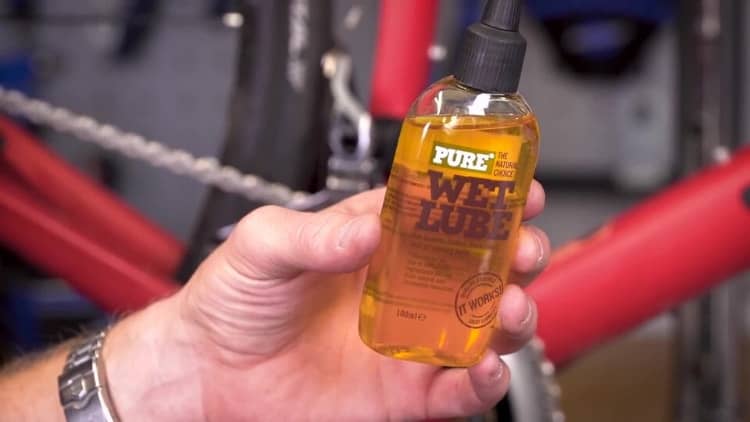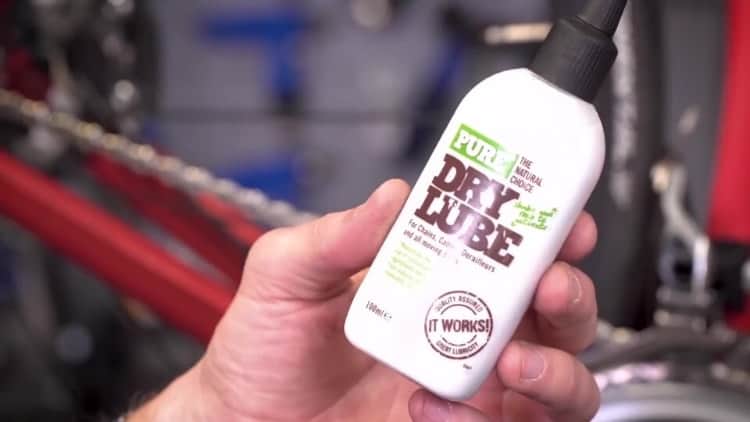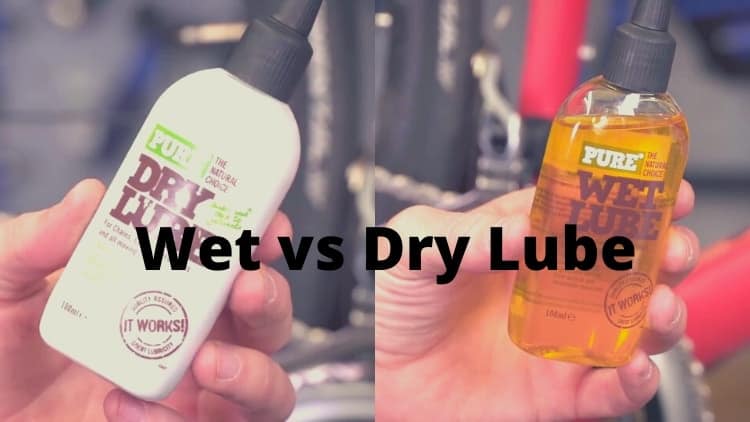Just about every rider knows how important it is to keep a lubed chain.
Your chain is the life force behind your bike and can be the determining factor between a thrilling ride and a long walk back to the car.
Luckily, your bike chain is one of the strongest parts on your bike – as long as you care for it properly.
But this is where it can get tricky.
As I mentioned before, most riders are aware of the importance of keeping a properly lubed chain. But there is some confusion when it comes to doing so. Specifically, when it comes to using the right chain lube.
When it comes to chain lube, riders have two options, both Dry and Wet lubes.
But how do you know what to pick?
In this article, we go over the difference between Dry and Wet lube, along with a few tips to help you decide which is best for you.
Wet lube is an all-weather lube that works best when riding in wet conditions. It is thicker than dry lube, which helps it repel water and keep your chain lubricated. Wet lube also attracts more dirt and grime, and requires consistent cleaning and reapplication. Dry lube is a lightweight lube that penetrates deep into your chain links. It is a lot less messy compared to wet lube, even with repeat applications, however, it will wash off easily if it gets wet.
Let’s explore the advantages and disadvantages of both types of lube, as well as some tips to help you decide which is best for you and your riding style.
What is Wet Lube

Pros and Cons
- Superior protection from rust and corrosion
- Effective in wet and muddy environments
- Long-lasting protection
- More Lubrication in each bottle
- Attracts more dirt and debris
- Requires more maintenance
- Can be messy to deal with
Before we get started, I wanted to first give a quick summary of what Wet Lube is.
As I mentioned before, Wet Lube is the original lube riders would use on their bike chains.
And while it originally started as a higher-quality version of oil, it is now more sophisticated than ever.
The Wet Lube sold today is made to be some of the most long-lasting lube available.
It also does an amazing job of repelling and displacing water – something that can quickly cause problems with your bike chain.
This is why it gets its name, as it does not get washed off when riding in wet conditions.
Wet lube goes on wet and stays “wet” until it is time to reapply.
Unfortunately, the stickiness of Wet lube also invites more dirt and debris into the chain.
Once the dirt mixes with the lube, it can create a type of paste that then grinds away at your chain links.
Wet lube will also thicken if left on too long, which can severely impact your drivetrain.
Without proper maintenance, Wet lube can make your bike chain wear down a lot faster.
And you can’t just reapply the lube like how you would with Dry Lube.
When you need to reapply, you must first clean and completely degrease your chain before applying more lube.
This can be a pretty daunting task, especially when you start to need more frequent applications.
What is Dry Lube

Pros and Cons
- Does not attract dirt or gunk up
- Can be reapplied without cleaning
- Less messy compared to Wet Lube
- Easier to maintain
- Does not last as long as wet lube
- Washes off easily
- Not as much “lube” per bottle
Dry lube is a newer innovation compared to Wet Lube; however, it has grown to become the lube of choice.
In an effort to reduce the negative side effects of the Wet Lube at the time, cyclists started to experiment with the different ways you could lube a bike chain.
One of the most promising methods for doing so involved heating your bike chain in a pan with wax.
The goal was to find a way to fully lubricate your bike chain, without running the risk of clogging your chain.
The wax did a good job of keeping the chain lubed, but the process was a little too involved for the average rider.
Luckily, manufacturers quickly caught on – and before you knew it, they had figured out a way to melt the wax with a chemical that would then evaporate.
The goal was to create a lube that would go on wet, and then dry as the liquid portion evaporates.
Dry Lube was born.
And although it does a good job of keeping your chain lubricated without attracting dirt, it still has its disadvantages.
One of the first is its short lifespan.
Dry lubes do not last as long as most Wet lubes, and this gets worse when you add water.
Due to their lightweight nature, most Dry Lubes will wash off with even the most modest amount of water.
When to use Dry Lube

Now that we know the purpose of Dry Lube, it is time to go over the best times to use it.
And this is something that really depends on you and what you ride.
The good news is that Dry Lube is really “beginner-friendly”.
It is really easy to get a hold of and even easier to use.
The only real risks you have are riding in wet conditions or going for extended periods of time without lubing your chain.
For these reasons, along with the properties of Dry Lube, you should use Dry Lube if you:
- Are a Beginner Rider
- Ride on dry or rocky trails
- Like to lubricate often
- If you do not clean or degrease your chain frequently
Of course, there are more instances where a Dry Lube will do fine.
As I said, most lubes are meant to work in all weather conditions, you just have to adjust how you apply and clean.
When to use Wet Lube

Wet Lube is not as “forgiving” as Dry Lube, however, it can be absolutely necessary in some instances.
Just like Dry Lube, Wet Lube is meant to be an all-season chain lube.
But it really excels during Winter months or during seasons where you get more rain and humidity.
Wet lube is especially helpful during the Winter months, as it can stop salt from getting to your chain, causing all types of havok.
For these reasons, it is recommended that you use Wet Lube when you:
- Need to Silence a noisy bike chain
- Need More Lubrication
- Riding during winter
- Riding in Wet or Muddy Conditions
Again, try to review your riding preferences before you decide to use Wet Lube.
And make sure you have a solid degreasing and cleaning routine to go along with it.
How to Apply Chain Lube
Now that you’ve decided which chain lube is best for you, it is time to review the best way to apply them to your bike chain.
Luckily, the process is really straightforward, regardless if you use Dry or Wet Lube.
As a preface, you should always try to apply lube to a clean bike chain.
If you add lube on top of a dirty chain or old lube, you can run the risk of buildup, which will eventually eat away at your chain links.
You can clean your chain with a toothbrush, a degreaser, and some clean water, however, I like using an actual chain cleaning kit.
One of the first things I bought when I started riding was this Chain Cleaning Kit from Park Tool. It came with all the tools and chemicals needed to clean a chain, so I knew what I was using on my bike was safe. I also like the cleaning tool, as it’s a lot quicker and easier to use compared to the toothbrush method.
Once you’ve ridden your bike of all dirt and old lube, it is time to apply.
How to apply Wet Lube
- Make sure your bike chain is completely clean and clear of dirt and oil
- Apply lube on the part of the chain below the chain stay, not above
- Start to pedal your bike backward as you drop a modest amount of lube on the inside of each chain link.
- Stop applying lube when you get to the chain link you started with
- Wipe away any excess lube
- Let the lube set for 2-12 hours before riding
How to apply Dry Lube
- Apply lube on the part of the chain below the chain stay, not above
- Start to pedal your bike backward as you drop a modest amount of lube on the inside of each chain link.
- Stop applying lube when you get to the chain link you started with
- Wipe away any excess lube
- Let the lube set for 2-12 hours before riding
What are the Different Types of Bike Chain Lube?

Although we went over the two main types of chain lube in this article, I will also provide some info on the other types of chain lube you may encounter.
Wet – Wet lube is a lube meant for riding in wet or muddy conditions. It lasts long but can attract dirt and buildup over time.
Dry – Dry lube is a lightweight lube that can be applied multiple times; however, it does not last long and washes off easily with water.
All-weather – All-weather lube is a mix between Wet and Dry lube.
Wax – A Dry lube that contains no oil or grease. Meant to provide superior protection without attracting dirt or buildup.
Ceramic – A wax-based lubricant meant to last longer than standard wax bike chain lube.
Based on budget, availability, and riding preference, you may find that you prefer one type of lube over another.
To help decide which is best for you, try to experiment with the different bike chain lubes available.
Remember to clean and degrease before switching lubes though.
What is the best lubricant for a bike chain?
Again, when it comes to the best bike chain lubricant, it really comes down to the rider and the type of conditions they plan to ride in.
First, decide whether or not you need a Wet or Dry lube, and then experiment with the different compounds available.
If you’re looking for a good balance between the two, try a Hybrid or a Ceramic Mix like Muc Off’s C3 Ceramic Lube.
Tips for applying bike chain lube
- Let the lube sit overnight or at least a few hours before riding
- Always wipe away excess to avoid buildup and attracting dirt
- Always apply to the section of the chain below the chainstay
- Always clean and degrease before applying wet lube to your chain
- Always clean and degrease before changing between Dry and Wet Lube
Conclusion
In conclusion, it is pretty easy to decide whether or not you need a Dry or Wet lube.
Once you review the advantages and disadvantages of both, you are more prepared to make the right decision.
Good luck and safe riding!

